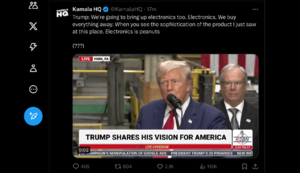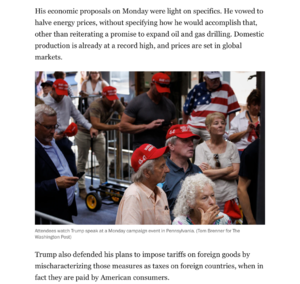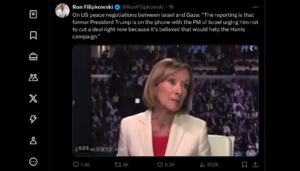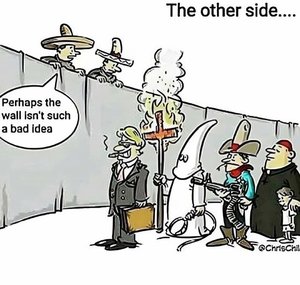Politikk, religion og samfunn President Donald J. Trump - Quo vadis? (Del 2)
- Trådstarter Høvdingen
- Startdato
Diskusjonstråd Se tråd i gallerivisning
-
^^Er han blitt fullstendig random?Dette verkar heilt vanvittig.Han karen i bakgrunnen ser ut som han ønsker han var et annet sted.
Moro med AI, og Trump gjør hva han kan for å hjelpe Harris.Selv etter Trumps standard for selvdestruktivt idioti tror jeg dette var veldig veldig dumt av ham. Man kødder ikke med en person som kan si «hopp» til tilhengerne sine og får målbare utslag på Richters skala som respons. Advokater har hun også. Skarpskodde, ikke sånne som Trump holder seg med.
Vis vedlegget 1048934
Muskler vejer mere end fedt men tvivler alligevel. Trump er snart en saga blot.Det kom tørt fra en kommentator: He's a heavily overweight old guy with a ridiculous comb-over and a badly applied orange spray tan.
Og fra en annen, i forhold til de 270 valgmennene man jakter for å vinne valget.
"The only way Trump will reach 270 is if he loses 40 pounds."
Trump er vel aldri i samsvar med virkeligheten. Han opplyste en tid tilbake at han veier 97 kilo og er 190 høy. Det utløste en haug sammenligninger.
Vis vedlegget 1048580
Vis vedlegget 1048581
Vis vedlegget 1048578
Finder du dig i at Sluket kalder dig idiot Asbjørn?
Washington Post skriver interessant om det, og hva de ønsker å oppnå.Selv etter Trumps standard for selvdestruktivt idioti tror jeg dette var veldig veldig dumt av ham. Man kødder ikke med en person som kan si «hopp» til tilhengerne sine og får målbare utslag på Richters skala som respons. Advokater har hun også. Skarpskodde, ikke sånne som Trump holder seg med.
Vis vedlegget 1048934
A week after Donald Trump falsely accused Kamala Harris’s campaign of using artificial intelligence to fabricate campaign images, he appears to have done just that.
Over the weekend, the Republican presidential nominee shared a pair of posts on his social network, Truth Social, that included AI-generated images: one depicting a hammer-and-sickle flag over a Soviet-style Harris rally, another showing young women in “Swifties for Trump” T-shirts. On Sunday, he reposted the Harris image to X and on Monday sent an email to supporters, calling it “the photo Kamala doesn’t want you to see.”
What’s noteworthy isn’t just that Trump is turning to generative AI to blur the truth. It’s the casual, almost mundane way he’s using it so far: not as a sophisticated weapon of deception, but as just another tool in his rhetorical arsenal.
Experts have been warning for years of AI’s potential to fuel political misinformation. For many, the nightmare scenario centers on a sophisticated, AI-generated or manipulated video that tricks millions into believing a bombshell falsehood. Imagine a video that appears to show election workers secretively trashing ballots or a candidate accepting a bribe.
Although there have been a few examples like that, especially abroad, Trump’s use of AI over the weekend illustrates a simpler — and, so far, much more common — application of the technology.
The images of Swifties for Trump and Harris as a communist leader don’t appear intended primarily to fool people, though of course some might be taken in. Some of the Swifties images, part of an X post of which Trump shared a screenshot, carried a “satire” label. The Harris image was unlabeled but patently unrealistic.
Rather, the images seem to function more like memes, meant to provoke and amuse. They’re visual parallel to the nasty nicknames Trump calls his opponents and the evidence-free claims he often makes on the campaign trail. For a politician whose favored rhetorical mode is the unconfirmed anecdote — “Many people are saying ...” — generative AI offers a handy new way to illustrate his stories.
This becomes evident when you view the images Trump posted over the weekend in the context of his other Truth Social posts. Far from standing out, the AI depictions of Harris and Taylor Swift nestle right into a timeline replete with satirical songs, Photoshopped images, jabs at “Comrade Harris” and dubious claims about rally crowd sizes.
The same day that Trump posted the AI image of Harris with the hammer-and-sickle banner, the New York Post’s front page portrayed Harris speaking from a dais adorned with a giant hammer-and-sickle logo, under the banner headline “Kamunism.” Trump posted that, too.
The distinction between AI memes and deepfakes might seem trivial at first. Both uses of the technology serve to smear political rivals and muddy the informational waters. Both also contribute to the so-called “liar’s dividend,” in which the proliferation of fakes and falsehoods makes it easier for people to dismiss the truth as a fabrication — as Trump did when he suggested that Harris had “A.I’d” a genuine photo of a large crowd greeting her in Michigan.
But a convincing deepfake is hard to make, at least for now, whereas generating less-realistic AI images is easier than ever. Even as leading AI image tools such as OpenAI’s Dall-E 3 and Midjourney have sought to prevent users from generating images that could be associated with political misinformation, Elon Musk’s X last week debuted a new version of its Grok AI tool that has few such limitations. A report on Monday by NewsGuard, a company that tracks misinformation, found that Grok complied with 16 of 20 test requests to produce such images; Midjourney complied with nine and Dall-E two.
And while a deepfake needs careful debunking, AI memes are impervious to fact-checks; the intended audience doesn’t care whether they’re literally true. The fake images feel true on some level, or at least it’s enjoyable to imagine that they might be. And if the other side gets righteously riled up, the joke is on them. (Democrats troll, too; think JD Vance and the couch.)
We may yet see more sophisticated attempts to dupe people with realistic AI fakes in this election cycle, or in others to come. But we also shouldn’t be surprised if AI continues to be used more for propaganda than trickery. As Mike Caulfield, an information literacy expert and an author of the book “Verified,” put it in a recent blog post:
“The primary use of ‘misinformation’ is not to change the beliefs of other people at all. Instead, the vast majority of misinformation is offered as a service for people to maintain their beliefs in face of overwhelming evidence to the contrary.”
In reality, any involvement in the election from Swift would probably work in Harris’s favor. But the world of AI offers Trump and his backers an appealing alternate reality in which the Harris campaign is in shambles and even Swifties are turning against her.
Whether playing pretend in this way will help or hurt Trump at the polls in November is unclear. But if his Plan B is to question the results of the election, a supporter base accustomed to living in fantasyland could come in handy.
- Ble medlem
- 19.09.2014
- Innlegg
- 21.741
- Antall liker
- 14.348
Trump sin forståelse av hvordan tariffer funker har vel alltid vært litt såder.Bare å kjøre på med nytt søksmål mot svinet. Han innbiller seg at han fortsatt er President... "Jeg fikset opp i Midt-Østen" "JEG ga de Golanhøyden"
Gud bedre for en syk faen! Håper han blir medlem av den eksklusive klubben av folk som tidligere har blitt tiltalt etter Logan paragrafen. Hele to stykker... skulle jo passe DT bra, han liker jo å være eksklusiv!
Henry Kissinger torpederte Vietnam fredsforhandlingene på order fra Nixon for å få Nixon valgt. Det kostet hundretusenvis av liv, kanskje endog millioner, men Kissinger døde mett av dager uten noensinne å ha blitt stilt til ansvar. Jeg ville ikke fått noen forhåpninger med andre ord.Bare å kjøre på med nytt søksmål mot svinet. Han innbiller seg at han fortsatt er President... "Jeg fikset opp i Midt-Østen" "JEG ga de Golanhøyden"
Gud bedre for en syk faen! Håper han blir medlem av den eksklusive klubben av folk som tidligere har blitt tiltalt etter Logan paragrafen. Hele to stykker... skulle jo passe DT bra, han liker jo å være eksklusiv!
Sist utnevnte han jo like godt sin jødiske voksfigur av en svigersønn til å skape fred en gang for alle i Midtøsten, så hvorfor ikke.
Demokratene har selvsagt sine svin på skogen også, men vi har tross alt kommet dit at Abe og Ikes gamle parti har blitt korrumpert inn i det absurde.
De fikk stoppet våpenpakken til Ukraina midt i en storkrig som representerer alt konservative republikanere har vært mot, og som attpåtil inneholdt tidenes største innsats mot ulovlig immigrasjon fra Mexico og hva de har gnålt om i et tiår, alt fordi det ikke var i Trumps egeninteresse å få noen løsning.
Selvsagt har Trump ingen interesse av noen varig våpenhvile i Gaza før valget. Like lite som Reagan hadde av å få løs de amerikanske gislene fra ambassaden i Tehran før valget i 1980.
Så helt nymotens, som @HC også er inne på, er jo dette ikke.
Nå har jo GOP uansett beveget seg svært langt bort fra Reagans republikanere.
Så får vi se om etterhvert mer tilårskomne Høyre-medlemmer åpner opp for å se Reagan i lys ikke bare av hvilken rolle han hadde på 80-tallet og hva han var for og mot da, men også i forhold til hans historiske betydning hva gjelder utviklingen mot det GOP vi ser i dag.Sist redigert:Jeg var vel ikke noen stor fan av Reagan da det sto på, men for min del preges nok ettermælet hans både av at man fikk knekt inflasjonen og avsluttet den kalde krigen i hans periode.
Uansett, gjøken som er opptatt av publikumsantall og TV ratings vil ikke like dette:

Surging Dems Post MONSTER Television Ratings - Blows Out Trump by a Whopping 21%!
The first night of the ongoing Democratic National Convention in Chicago had significantly better ratings than the opening of the Republican National Convention last month, according to overnight data. *** Some running the DNC surely were concerned...www.dailykos.com
Nå skal vel Dutch få hvile i fred i denne tråden, men jeg mener nå som mange historikere at han har fått alt for mye kred for både inflasjon og avslutning av den kalde krigen. For ikke å snakke om hvordan han fikk alzheimet seg ut av Iran-Contras affæren, en politisk skandale og forbrytelse som fikk Watergate til å fremstå som en småslurvet administrativ forseelse.Jeg var vel ikke noen stor fan av Reagan da det sto på, men for min del preges nok ettermælet hans både av at man fikk knekt inflasjonen og avsluttet den kalde krigen i hans periode.
Men i motsetning til Trump hadde Reagan tross alt også en rekke politiske og personlige kvaliteter man kunne verdsette selv om man ikke var republikaner eller konservativ.Kjapp påminnelse om Iran-Contra. Fra 1981-1986 solgte USA våpen til mullahene i Iran, og brukte pengene for å betale for sin hemmelige krig mot styret i Nicaragua, i håp om å styrte dette.Ikke helt fersk lenger denne, men et veldig interessant innblikk i hvordan media dekker (eller ikke dekker) saker, og hvordan pressen påvirkes og påvirker.

TV giant known for rightwing disinformation doubles down on its national news agenda
Media analysts say Sinclair, known for anchors reciting script in lockstep, promotes conservative talking pointswww.theguardian.com
Sist redigert:Reagan var i det minste bedre til og fortelle vitser enn det DT er...
Det, samt koblingen til de amerikanske gislene som Hizbollah holdt fanget i Libanon.Kjapp påminnelse om Iran-Contra. Fra 1981-1986 solgte USA våpen til mullahene i Iran, og brukte pengene for å betale for sin hemmelige krig mot styret i Nicaragua, i håp om å styrte dette.- Ble medlem
- 13.10.2005
- Innlegg
- 21.439
- Antall liker
- 6.853
Ikke best i klassen allikevel altså, hvem så vel den komme.

Trump Humiliated After Claiming He Graduated ‘First in His Class’ From College — Wharton Proves He’s Lying (With Receipts!)
I am always amazed at people like Donald Trump who lie about things that can be easily proven to be lies. Like, what’s the point? Doesn’t he realize people will check, realize he is lying, and just not believe anything he says? Or does he not care? Or does his broken brain honestly believe the […]www.politicalflare.com
Michael Cohen says Trump directed him to threaten his high school, colleges, and the College Board to never release the president’s grades or SAT scores
x.com
 x.com
x.com
Siste nytt om presidentvalget i USA 2024
Korte oppdateringer og svar på det du lurer på om valget.www.aftenposten.no
Det rart at ingen utskrifter av karakterene hans har lekket ut, trusler eller ei.Ikke best i klassen allikevel altså, hvem så vel den komme.

Trump Humiliated After Claiming He Graduated ‘First in His Class’ From College — Wharton Proves He’s Lying (With Receipts!)
I am always amazed at people like Donald Trump who lie about things that can be easily proven to be lies. Like, what’s the point? Doesn’t he realize people will check, realize he is lying, and just not believe anything he says? Or does he not care? Or does his broken brain honestly believe the […]www.politicalflare.com
Michael Cohen says Trump directed him to threaten his high school, colleges, and the College Board to never release the president’s grades or SAT scores
x.com
 x.com
x.com
Han har jo skrytt av at han var på Wharton. Men det var kun noen måneder, så det spørs om det er noen karakterer å lekke derfra.Det rart at ingen utskrifter av karakterene hans har lekket ut, trusler eller ei.
"Perhaps Ms. Harris has qualities of leadership we haven’t observed. Vice Presidents called on unexpectedly have sometimes risen to the occasion, as Harry Truman and Gerald Ford did. Perhaps, too, she will show some of those qualities in Thursday’s speech or in the campaign to come. But so far she is a vessel for the triumph of hope over experience, whom Americans are expected to embrace mainly because she isn’t Donald Trump."Jeg har sansen for Tim Walz. En mer ærlig og rett-frem fyr. En ikke sånn velregissert type som politikere på øverste nivå ofte er. Han sier det han mener, og mener det han sier.
En nordmann som har møtt Walz var på Nrk nyhetsmorgen i dag. Denne nordmannen har møtt Walz flere ganger, blant annet på jakt i Dakota. Han beskriver Walz som real, ærlig og nøktern mann som er diamentralt motsatt av Donald Trump. Hvor Trump sover i en seng som han har fått bygd som en kopi av franske Ludwig den XIVs himmelseng med forgylte utskjæringer og tunge draperier av gullbrokade, så lever Walz enkelt og reiser på økonomiklasse for å spare skattebetalerne for penger.
Walz er jo guvernør i Minnesota. Et tankekors er at Walz hadde 3 livvakter med seg på fasanjakt. Det sier litt om type samfunn vi lever i dag.- Ble medlem
- 13.10.2005
- Innlegg
- 21.439
- Antall liker
- 6.853
Kan det tenkes at kineserne nå vurderer ulempene med at Trump varsler kraftig tolløkning på impert fra Kina som høyere enn fordelene med at han skaper splid og uforutsigbarhet i vesten mm.? At kineserne aktivt påvirker opinionen er det lite tvil om, spørsmålet er i hvilken retning.Trump klarer fortsatt ikke dy seg, han må reagere og kommentere om noen tråkker ham litt på tærne. Alle vet jo hvor
tynnhudet han er, legger ut åte, og smekk så er han der. Om og om igjen.
Tiradene hans treffer de innbitte MAGA-velgerne, men de er jo allerede overbevist uansett. De som er usikre derimot, de ønsker å høre om politikk.
Dette har blitt innprentet gang på gang, han sier det jo akkurat selv til og med, men det ender opp med å handle om ham selv og hans sårede ego.
Hver bidige gang.
Smart av GOP å satse absolutt alt på denne ene stabile og geniale hesten.- Ble medlem
- 26.02.2013
- Innlegg
- 3.657
- Antall liker
- 3.377
Kanskje dem skal bruke Obama og Hillary litt oftere? Slik at Trumperen ikke klarer fokusere resten av tiden fram tl valget.
En kan jo da håpe at flere forstår hvor gammel og syk Trump er når han fortsetter snakke om individer og hendelser som kun er relevant for en gammel, egosentriske og bitter mann.Godt hjulpet av folk som George Conway også. Han redegjør greit for hvorfor han mener Trump åpenbart lider av et par ikke
ubetydelige personlighetsforstyrrelser.

Donald Trump is a narcissist and a sociopath. Here's the proof. - Anti-Psychopath Political Action Committee
Hey friends, I’ve been saying it for years: Donald Trump is a sociopath. It’s obvious when you listen to him speak for five minutes, or watch the deranged way he treats the people around him. But let’s take the time to go over, step by step, how Trump fits the established medical criteria, just... www.psychopac.org
www.psychopac.org
De målrettede kampanjene treffer godt.

George Conway’s “Anti-Psychopath PAC” Exposes Trump as a Liar and Cheater On and Off the Golf Course - Anti-Psychopath Political Action Committee
WASHINGTON – Monday, August 12, 2024 – Today George Conway’s Anti-Psychopath PAC launched a new six-figure billboard campaign spotlighting the fact that Donald Trump is a liar and a cheat — on the golf course and off. This initiative underscores Trump’s unfitness for office by highlighting his... www.psychopac.org
www.psychopac.org
-
Laster inn…
Diskusjonstråd Se tråd i gallerivisning
-
-
Laster inn…














